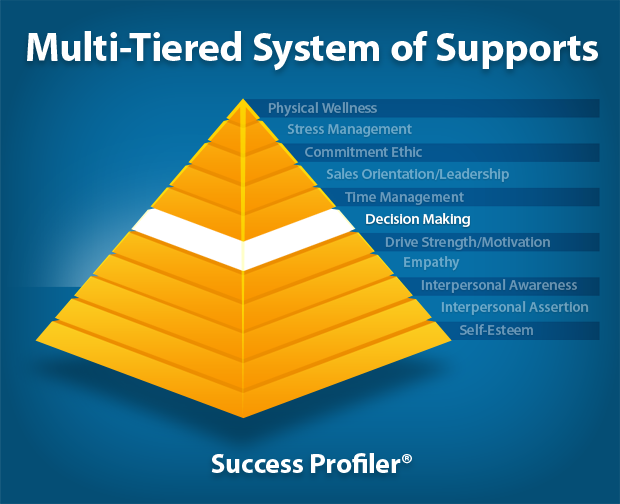
The sixth step in our Success Profiler social/emotional pyramid is Decision Making. It is important to note that decision making is a process that follows problem solving. Decision making is using problem solving skills to discover a course of action that will most likely achieve the results you want.
Decision making is used because one wants something to happen, where problem solving is used when a question needs to be answered.
Decision Making is a Key Social/Emotional Skill
Decision Making is part of our social/emotional process and is a scale in our Personal Skills Map. The reason Decision Making is so important in our social/emotional process is simple to understand. Every interaction with another person or thing requires good decision making skills. Whether one is trying to develop a friendship or decide which school to attend, it makes no difference. A good decision needs to be made in order to succeed.
Decision Making Also Impacts MTSS
Multi-Tiered System of Supports or MTSS is a term used to describe an evidence-based model of schooling that uses data-based problem solving to integrate academic and behavioral instruction and intervention (Florida’s MTSS Project). This definition suggests that problem solving which leads to good decision making is necessary for teachers to assist students in the MTSS process. We can easily agree with that—but what about the students? Don’t they need good decision making skills as well? Poor problem solving and decision making skills created the need for MTSS-based intervention in the first place.
Not Just for Teachers Anymore
It is our belief that good decision making skills are equally important for both students and teachers. Good decision making on the part of the student can lead to academic success. Deciding to stay home and study on the night before a semester exam instead of going out with friends is an example of good decision making skills that will lead to academic success.
The 8 Step Decision Making Process
There are many theories on how to make a good decision. All of these theories rely on gathering information about a problem, analyzing the data and then making a decision.
Here is a very solid, eight-step approach to decision making:
- State the problem.
- Accept the responsibility to solve the problem.
- Collect data or information.
- Organize the data.
- Interpret the data.
- Find the real causes.
- Put a decision into action.
- Test the results.
Want to try out our Personal Skills Map? Click here.
